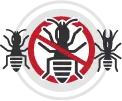If you’ve noticed small, winged insects with distinctive red and white spotted patterns, you have encountered a spotted lanternfly in the wild. While you may have heard that you should stomp on these insects on sight, you may not fully realize how dangerous spotted lanternflies are to the surrounding environment. While they do not pose a threat to bite humans or animals, their preferred food source has a worse time — the nearby plants and trees.
Spotted lanternflies feed on plant sap, weakening vital tree species, herbaceous plants, and economically important crops. Their feeding habits damage both understory plants and canopy trees, leading to stunted growth and reduced plant health. As they feed, spotted lanternflies excrete a sugary substance that promotes sooty mold, further harming plants and trees, and even staining lawn furniture and outdoor furniture. Spotted lanternflies are an invasive species with a strong preference for specific host plants, including the tree of heaven, though their impact spans many tree species. These insects’ broad black bands and colorful hind wings are more than an aesthetic concern—they are a red flag for serious damage. Without proper control, the infestation spreads quickly, leaving both native insects and beneficial insects at risk.
How Dangerous Are Spotted Lanternflies?
Spotted lanternflies are more than just a cosmetic concern for plants. They are dangerous for your plants, trees, and the environment at large if left unchecked. These insects harm by feeding on the sap of various tree species and other plants, leading to diminished plant health. As spotted lanternflies feed, the excessive loss of sap weakens plants, making them more susceptible to other insects and diseases. Spotted lanternfly feeding also leaves behind sooty mold, which reduces plants’ photosynthesis ability. Spotted lanternflies lay egg masses on tree trunks, outdoor furniture, and even vehicles, allowing them to spread rapidly. When they target adult plants, they disrupt the life cycle and growth of the preferred host plant and many native insects. Given their invasive nature and rapid spread, they threaten quarantine zones and require diligent control. Spotted lanternflies are particularly dangerous in quarantine zone areas, where they can lead to further damage to plants, trees, and crops.
How They Harm Plant Species & Trees
Spotted lanternflies feed on various host plants and tree species, causing significant damage. Their feeding can lead to stress on vulnerable plants and tree roots, weakening them over time. As they feed on plant sap, spotted lanternflies leave a sugary substance behind, which attracts sooty mold that covers plants, disrupting their natural functions. This sticky residue stains outdoor furniture, cars, and other surfaces, becoming a nuisance beyond just plant health concerns.
Spotted lanternflies lay eggs on trees and other surfaces, ensuring a new generation of these invasive pests will continue damaging plants. Their feeding also affects economically important plants, such as grapevines, reducing crop yields. By targeting a plant’s sap, spotted lanternflies make it easier for secondary pests to attack. Over time, their feeding significantly stresses host plants and other species, impacting the broader ecosystem. Controlling spotted lanternflies is essential to preventing the long-term decline of tree species and plant health.
Signs You’re Dealing With a Spotted Lanternfly Problem
Dealing with a spotted lanternfly infestation can devastate your plants and trees if not caught early. The most obvious signs include clusters of spotted lanternfly egg masses, which can appear on tree trunks, lawn furniture, or even outdoor surfaces like decks and vehicles. These egg masses look like grayish or tan patches, often mistaken for a simple buildup of dirt. You may also notice a sugary substance left behind by spotted lanternfly feeding, which promotes the growth of sooty mold. This mold coats leaves, reducing the plant’s ability to photosynthesize, and it can stain everything from backyard plants to patio furniture. The following signs often indicate a serious spotted lanternfly problem:
- Grayish or tan spotted lanternfly egg masses on tree trunks or outdoor furniture.
- Black, powdery, sooty mold covers vulnerable plants’ leaves and branches.
- Reduced vitality in trees and understory plants due to slf feeding.
- Large numbers of adult slf tend to gather on tree species, leaving behind damage.
- Sticky residue, known as honeydew, coats plant surfaces and attracts other insects.
Don’t let these pests gain a foothold in your property. If you notice any of these warning signs, it’s time to bring in the experts and get rid of your spotted lanternfly problem for good!
Is Stomping Them on Sight Enough?
While stomping a spotted lanternfly may provide immediate satisfaction, it’s far from enough to control an entire infestation. Spotted lanternflies lay eggs in hard-to-reach places, meaning more will hatch, even if you squash a few adults. These invasive insects quickly spread, laying their slf egg masses on host trees, lawn furniture, and even vehicles, allowing them to expand rapidly beyond your yard. Killing slf adults might reduce some visible populations, but it won’t address the eggs that will soon hatch or the nymphs in other life stages.
Professional spotted lanternfly treatment uses proven techniques to combat the infestation and protect your greenery without causing undo harm to the environment. These methods target slf at different life cycle stages, ensuring a more comprehensive approach to managing slf. Protect surface water and bee health by applying insecticides carefully to prevent contamination. Professional services also help manage slf populations while preserving beneficial insects, natural enemies, and other important ecological factors.
Schedule Your Next Spotted Lanternfly Control Service in New Jersey Today
Don’t wait until your backyard plants and trees suffer irreversible damage. Protect your home, garden, and surrounding areas from the dangers of a spotted lanternfly infestation. Arrow Pest Control offers professional services that help control slf, reduce insecticide residue, and prevent further damage to your trees and plants. Our treatments focus on using effective biological control options while minimizing the impact on native insects and beneficial insects. If you’re in a quarantine zone or dealing with a severe infestation, we’ll manage slf populations before they spread further. Our approach ensures your plants remain healthy and vibrant throughout your home. Ready to beat back your spotted lanternfly infestation? Call us and schedule your next residential pest control service in New Jersey today!

Free Home Estimate
"*" indicates required fields

